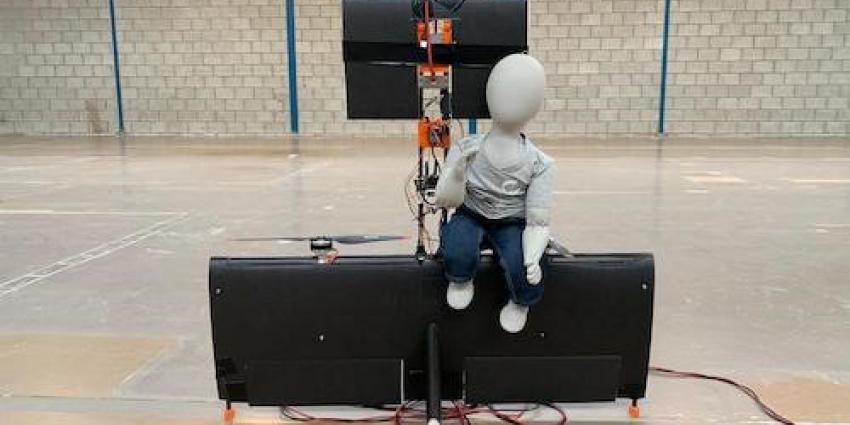As one of five finalists in the Boeing sponsored GoFly Prize, TU Delft’s own team Silverwing aims to win with its S1 design, a personal flying motorcycle.
Although it might seem like something out of a science fiction movie, human flight may soon become a reality. By founding the GoFly Prize, CEO Gwen Lighter set out to stimulate innovation in the development of personal flying devices. The three-phase global competition, announced in November 2017, aims to foster the development of safe, quiet, ultra-compact, near-VTOL (vertical take-off and landing) personal flying devices capable of flying twenty miles while carrying a single person.
Making people fly
TU Delft’s Silverwing came into being when two aerospace students put together a small team to submit a concept for the first phase of GoFly. When their idea was selected as one of the top ten out of hundreds of entries, Technical Manager Victor Sonneveld, a master’s student, and Team Manager James Murdza (BSc 2018) quickly pulled together a larger multi-disciplinary team. It has since grown to 34 students representing ten nationalities and nearly every faculty at TU Delft.
In March, team Silverwing learned they had been chosen as one of the top five designs by GoFly. During this second phase of the competition, teams had to present a more detailed design and built various test set-ups, including a half-scale prototype. The S1, a tailsitter aircraft, rotates 90 degrees to take off and land on its tail, requiring no runway and less space than a car. “It’s basically a flying motorcycle, but what makes it special is that it takes off and lands vertically,” said Ruben Forkink, an aerospace graduate and Silverwing Chief of Partnerships & Business Development. “At the desired altitude you transition from vertical to horizontal flight and then you basically ride it like a motorcycle and transport yourself from A to B. Then you transition back from horizontal flight to land vertically on your tail.”
Going beyond the call
Although it was not a requirement of the competition, the S1 is battery powered, fully electric and able to fly autonomously. “We’re one of the few teams that opted to go completely electric,” said Nisarg Thakrar, an aerospace master’s student and member of the Silverwing structures team. “From our point of view, to be successful, it has to achieve the modern requirements, being electric and autonomous.” And although the limitations of battery technology make it challenging to carry the required amount of weight, making it autonomous means that the S1 could be used to transport packages, not just people.
Students bring a lot to the table
As competitions go, the GoFly Prize is unique in that it is open to anybody from anywhere in the world. “What’s really great and what makes us stand out is that we are the only undergrad team in the finals,” said Forkink. The other finalist teams include PhDs, researchers and companies with industry experience. “We have a lot of bachelor’s students on our team so it’s a challenge, but that’s what we really like,” noted Forkink. “We are able to combine the knowledge from all of these faculties and that makes us a real multidisciplinary team.”
Putting hands-on education to work
The aerospace faculty has played an integral role in Silverwing’s design and development process. According to Forkink, the team has members from all of the different tracks at aerospace, and knowledge gained in the classroom has been useful. “We have students that go to their lecture and 30 minutes later they come here and start working on what they just learned.” And Thakrar believes the master’s programme structures track has been a huge asset in the design of the S1. “We do most of our own work, but we do have limitations and at that point we can consult with professors as well as external parties that help us,” he said. “In my opinion, one of the best ways to be a good engineer is through application, not only through books and this project has been a great way to support that idea.”
The final stage
Team Silverwing is currently finalising the S1 design to prepare for manufacturing and they hope to have a test flight by the end of this year. In early 2020, they will participate in a final fly-off in the United States. During this last stage of the competition, the aircraft must take off vertically, cover an eleven-kilometre course and then land again vertically. Points will be awarded for low noise levels, size (the smaller the better) and speed. The winning team will receive a US$ 1 million grand prize.
"GoFly is excited to see Team Silverwing-- a young team made up of many undergraduates-- competing with established companies and veterans of the industry, and holding their own,” said Lighter. “Team Silverwing brings novel innovation and out-of-the-box thinking to their personal flyer. We look forward to seeing Team Silverwing at the GoFly Final Fly Off next year, and we can’t wait to see them change the world."
On April 30, 2019 Silverwing will unveil their award-winning design for the S1 to the general public. Want to see it? Click here.


